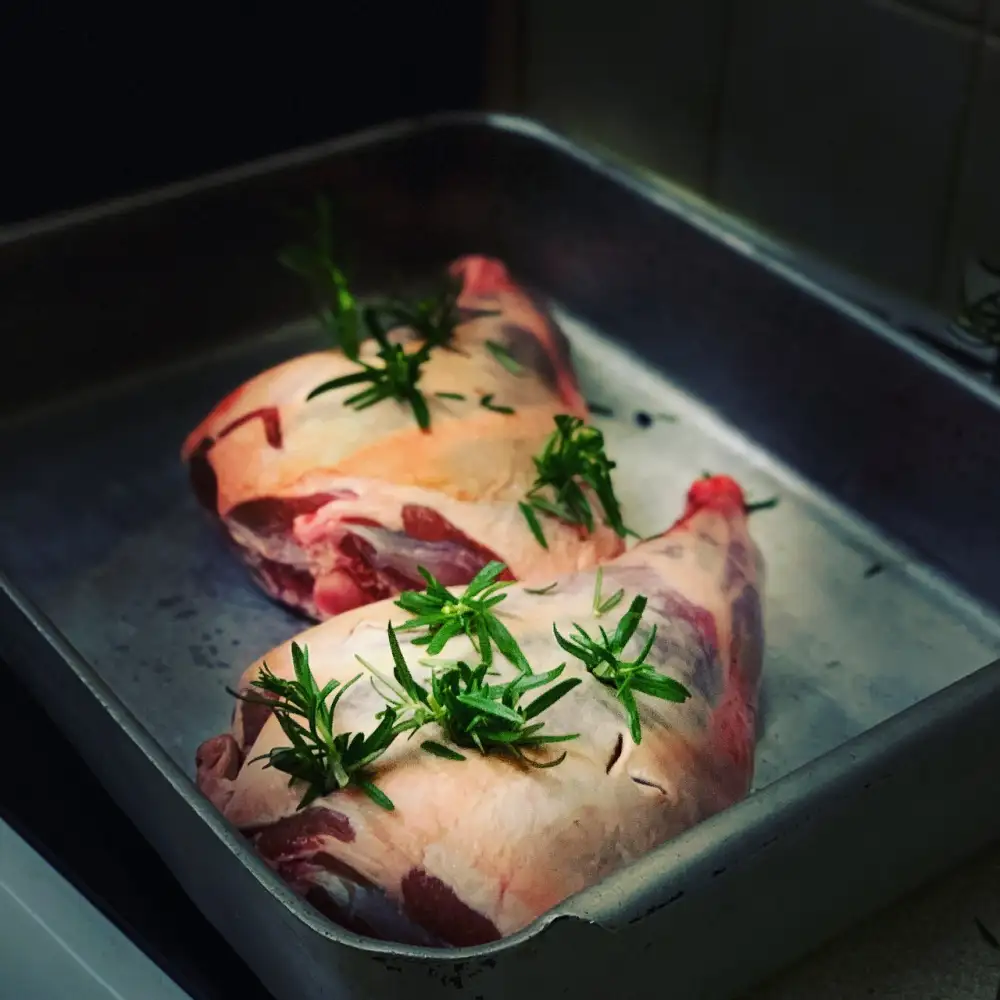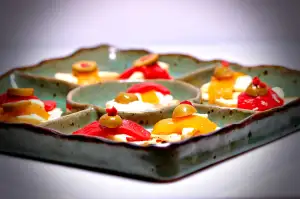Deliciously Tender: Master the Art of Cooking a Leg of Lamb with This Flavorful Recipe

- Ingredients needed for cooking a leg of lamb
- Preparing the leg of lamb for cooking
- Seasoning the leg of lamb
- Cooking methods for the leg of lamb
- Roasting the leg of lamb
- Grilling the leg of lamb
- Slow cooking the leg of lamb
- Checking the doneness of the leg of lamb
- Resting and carving the leg of lamb
- Serving suggestions for the leg of lamb
A leg of lamb is a succulent and flavorful cut of meat that is perfect for special occasions or a Sunday roast. Cooking a leg of lamb may seem intimidating, but with the right techniques, you can easily master this dish. In this article, we will guide you through the process of preparing and cooking a leg of lamb to perfection. Whether you choose to roast, grill, or slow cook it, this recipe will result in a deliciously tender and mouthwatering meal that will impress your family and friends. So let's dive into the world of cooking a leg of lamb and discover the secrets to creating a truly unforgettable dish.
Ingredients needed for cooking a leg of lamb
To cook a delicious leg of lamb, you will need the following ingredients:
- 1 leg of lamb (approximately 5-6 pounds)
- Salt and pepper
- Garlic cloves
- Fresh rosemary sprigs
- Olive oil
These basic ingredients will help to enhance the natural flavors of the lamb and create a tender and succulent dish. Make sure to choose a high-quality leg of lamb from a trusted source for the best results.
Preparing the leg of lamb for cooking
To prepare the leg of lamb for cooking, start by trimming off any excess fat. This will help prevent the meat from becoming too greasy. Next, remove the silver skin, a thin layer of connective tissue, by gently sliding a sharp knife under it and lifting it away. This step is important as it can toughen during cooking if left on. Once the fat and silver skin are removed, pat the leg of lamb dry with paper towels to ensure a crispy exterior when cooked. Finally, bring the lamb to room temperature before seasoning and cooking to ensure even cooking throughout.
Seasoning the leg of lamb
Seasoning the leg of lamb is a crucial step in enhancing its flavor. Begin by generously rubbing the meat with salt and pepper, ensuring it is evenly coated. For added depth, create a marinade using garlic, rosemary, thyme, and olive oil. Massage the marinade into the lamb, allowing it to penetrate for at least two hours or overnight in the refrigerator. The herbs will infuse their aromatic essence while the salt helps tenderize the meat. Remember to bring the lamb to room temperature before cooking to ensure even cooking throughout.
Cooking methods for the leg of lamb
When it comes to cooking a leg of lamb, there are several methods you can choose from. Each method imparts its own unique flavor and texture to the meat, allowing you to customize your cooking experience. Here are three popular cooking methods for preparing a delicious leg of lamb:
1. Roasting: This is the most traditional method for cooking a leg of lamb. Preheat your oven to 325°F (165°C) and place the seasoned leg of lamb on a rack in a roasting pan. Cook for about 20 minutes per pound (450 grams) until the internal temperature reaches 145°F (63°C) for medium-rare or 160°F (71°C) for medium doneness.
2. Grilling: Grilling a leg of lamb adds a smoky flavor and beautiful char marks to the meat. Preheat your grill to medium-high heat and sear the seasoned leg of lamb on all sides for about 5 minutes. Then, reduce the heat to medium-low and continue grilling for about 15-20 minutes per pound (450 grams) until it reaches the desired doneness.
3. Slow cooking: Slow cooking is perfect if you want tender, fall-off-the-bone lamb. Place the seasoned leg of lamb in a slow cooker with some liquid, such as broth or wine, and cook on low heat for 8-10 hours or on high heat for 4-6 hours until it is fork-tender.
Choose the cooking method that suits your preference and equipment availability. Remember to adjust cooking times based on the size and thickness of your leg of lamb. Experimenting with different methods will help you discover your favorite way to cook this flavorful cut of meat.
Roasting the leg of lamb
Roasting the leg of lamb is a classic and popular method that brings out the rich flavors of the meat. To roast the leg of lamb, preheat your oven to 350°F (175°C). Place the seasoned leg on a roasting rack in a shallow pan. Insert a meat thermometer into the thickest part of the meat, making sure it doesn't touch bone or fat. Roast uncovered for about 20 minutes per pound (450g) for medium-rare doneness. Baste occasionally with pan juices to keep it moist and flavorful. Remember to let the roasted leg rest for 15-20 minutes before carving to allow the juices to redistribute evenly.
Grilling the leg of lamb
Grilling the leg of lamb is a fantastic way to infuse it with smoky flavors and achieve a deliciously charred exterior. To grill the leg of lamb, preheat your grill to medium-high heat. Make sure the grates are clean and lightly oiled to prevent sticking.
Place the seasoned leg of lamb directly on the grill grates, fat side down, and sear for about 5 minutes until it develops a nice crust. Flip the leg of lamb using tongs and sear for an additional 5 minutes on the other side.
Once seared, move the leg of lamb to indirect heat by turning off one burner or moving it to a cooler part of the grill. Close the lid and continue grilling for about 20-25 minutes per pound, or until it reaches your desired doneness.
Remember to monitor the internal temperature using a meat thermometer inserted into the thickest part of the meat without touching bone. For medium-rare, aim for an internal temperature of 135°F (57°C), while medium should be around 145°F (63°C).
To enhance flavor, you can baste the leg of lamb with a marinade or glaze during grilling. A simple mixture of olive oil, garlic, lemon juice, and herbs like rosemary or thyme works well.
Once grilled to perfection, remove the leg of lamb from the grill and let it rest for about 15 minutes before carving. This allows juices to redistribute throughout the meat for maximum tenderness.
Grilled leg of lamb pairs wonderfully with fresh herbs like mint or parsley, as well as tangy sauces such as tzatziki or chimichurri. Serve alongside roasted vegetables or a vibrant salad for a complete meal that will impress your guests.
Grilling a leg of lamb may seem daunting at first, but with practice and attention to detail, you can master this cooking method and create a succulent and flavorful dish that will be the star of any gathering.
Slow cooking the leg of lamb
Slow cooking is a popular method for preparing a leg of lamb as it results in incredibly tender and flavorful meat. To slow cook a leg of lamb, start by preheating your oven to 275°F (135°C). Place the seasoned leg of lamb in a roasting pan and cover it tightly with aluminum foil. This will help retain moisture during the long cooking process. Slow cook the lamb for approximately 4-5 hours, or until it reaches an internal temperature of 145°F (63°C) for medium-rare or 160°F (71°C) for medium. The slow cooking process allows the connective tissues in the meat to break down, resulting in a melt-in-your-mouth texture. Remember to baste the lamb occasionally with its own juices to keep it moist and flavorful.
Checking the doneness of the leg of lamb
Checking the doneness of the leg of lamb is crucial to ensure it is cooked to perfection. There are a few methods you can use to determine if your lamb is done. The most reliable method is to use a meat thermometer. Insert the thermometer into the thickest part of the meat, avoiding any bones. For medium-rare, the internal temperature should read 145°F (63°C), for medium it should be 160°F (71°C), and for well-done it should reach 170°F (77°C). Another method is to use a fork or skewer and pierce the meat. If the juices run clear with no trace of pink, it is likely cooked through. Lastly, you can also press on the meat with your finger. If it feels firm and springs back slightly, it is cooked to medium-rare. Remember that the lamb will continue to cook as it rests, so remove it from heat just before reaching your desired doneness.
Resting and carving the leg of lamb
Resting and carving the leg of lamb is an important step to ensure a juicy and tender meat. After cooking, remove the leg of lamb from the heat source and let it rest for about 15-20 minutes. This allows the juices to redistribute throughout the meat, resulting in a more flavorful and succulent dish.
While the leg of lamb is resting, cover it loosely with aluminum foil to keep it warm. This will also help retain its moisture. Avoid cutting into the meat immediately after cooking as this can cause the juices to escape, leaving you with a dry piece of lamb.
When it's time to carve, use a sharp carving knife to slice thin, even pieces against the grain. Start by cutting along the bone and then continue slicing across the meat. This will ensure that each slice is tender and easy to chew.
If you prefer serving individual portions, you can also remove the bone before carving. Simply locate the joint where the bone meets the meat and make a clean cut through it. Then proceed with slicing as desired.
Remember to serve your perfectly cooked leg of lamb on a warm platter or individual plates. Garnish with fresh herbs such as rosemary or mint for added flavor and presentation.
By following these steps for resting and carving your leg of lamb, you'll be able to enjoy every bite of this deliciously tender dish.
Serving suggestions for the leg of lamb
Serving Suggestions for the Leg of Lamb:
1. Classic Pairings: Serve the leg of lamb with traditional accompaniments such as mint sauce, rosemary-infused gravy, or a tangy cranberry relish. These flavors complement the rich and tender meat.
2. Mediterranean Twist: For a Mediterranean-inspired meal, serve the leg of lamb with roasted vegetables like bell peppers, zucchini, and eggplant. Add a side of couscous or quinoa salad dressed with lemon vinaigrette for a refreshing touch.
3. Middle Eastern Flavors: Create an exotic feast by serving the leg of lamb with aromatic rice pilaf flavored with saffron and spices like cumin and cinnamon. Accompany it with a side of creamy hummus, tzatziki sauce, or pita bread.
4. Spring Feast: Celebrate the arrival of spring by pairing the leg of lamb with fresh seasonal vegetables like asparagus, baby carrots, and new potatoes. Drizzle them with olive oil and sprinkle some sea salt before roasting for added flavor.
5. Fusion Delights: Experiment with fusion cuisine by serving the leg of lamb in tacos or wraps filled with vibrant ingredients like avocado salsa, pickled onions, and cilantro-lime crema. This adds a modern twist to this classic dish.
Remember to garnish your platter with fresh herbs like parsley or thyme to enhance both presentation and taste. Enjoy this succulent leg of lamb alongside your chosen sides to create a memorable dining experience!
In conclusion, mastering the art of cooking a leg of lamb can elevate your culinary skills and impress your guests with its tender and flavorful meat. Here are some final tips to ensure a successful outcome:
1. Choose a high-quality leg of lamb from a reputable butcher to guarantee the best flavor and tenderness.
2. Allow the leg of lamb to come to room temperature before cooking to ensure even cooking throughout.
3. Season the meat generously with salt, pepper, and any desired herbs or spices for enhanced flavor.
4. Consider marinating the leg of lamb overnight for maximum tenderness and flavor infusion.
5. Use a meat thermometer to check for doneness, aiming for an internal temperature of 145°F (63°C) for medium-rare or 160°F (71°C) for medium.
6. Let the cooked leg of lamb rest for at least 15 minutes before carving to allow the juices to redistribute, resulting in juicier meat.
7. Carve against the grain into thin slices for optimal tenderness.
8. Serve with accompanying sauces or condiments such as mint jelly, chimichurri, or tzatziki to complement the rich flavors.
By following these tips and experimenting with different cooking methods, you can create a mouthwatering leg of lamb that will leave everyone craving more. So go ahead and embark on this culinary adventure - your taste buds will thank you!
Published: 27. 02. 2024
Category: Recipes



